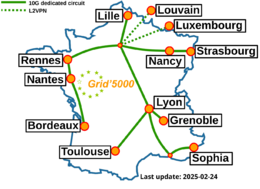Grid5000:Home
|
Grid'5000 is a precursor infrastructure of SLICES-RI, Scientific Large Scale Infrastructure for Computing/Communication Experimental Studies.
|
|
Grid'5000 is a large-scale and flexible testbed for experiment-driven research in all areas of computer science, with a focus on parallel and distributed computing, including Cloud, HPC, Big Data and AI. Key features:
Older documents:
|
Random pick of publications
Five random publications that benefited from Grid'5000 (at least 2924 overall):
- Mateusz Gienieczko, Filip Murlak, Charles Paperman. Supporting Descendants in SIMD-Accelerated JSONPath. International Conference on Architectural Support for Programming Languages and Operating Systems (ASPLOS 2024), 2024, San Diego (California), United States. pp.338-361, 10.4230/LIPIcs. hal-04398350 view on HAL pdf
- Hugo Thomas, Guillaume Gravier, Pascale Sébillot. One-shot relation retrieval in news archives: adapting N-way K-shot relation classification for efficient knowledge extraction. KES 2024 - 28th International Conference on Knowledge-Based and Intelligent Information & Engineering Systems, Sep 2024, Seville, Spain. pp.1060-1069. hal-04708239 view on HAL pdf
- Jan Aalmoes. Intelligence artificielle pour des services moraux : Concilier équité et confidentialité. Intelligence artificielle cs.AI. INSA de Lyon, 2024. Français. NNT : 2024ISAL0126. tel-05014177 view on HAL pdf
- Danilo Carastan-Santos, Georges da Costa, Igor Fontana de Nardin, Millian Poquet, Krzysztof Rzadca, et al.. Scheduling with lightweight predictions in power-constrained HPC platforms. IEEE Transactions on Parallel and Distributed Systems, 2025, pp.1-12. 10.1109/TPDS.2025.3586723. hal-04747713v3 view on HAL pdf
- Albert d'Aviau de Piolant, Hayfa Tayeb, Bérenger Bramas, Mathieu Faverge, Abdou Guermouche, et al.. Improving energy efficiency of HPC applications using unbalanced GPU power capping. HCW (Ipdps workshop), Jun 2025, Milan (Italie), Italy. hal-04883872v2 view on HAL pdf
Latest news
![]() End of support for centOS7/8 and centOSStream8 environments
End of support for centOS7/8 and centOSStream8 environments
Support for the centOS7/8 and centOSStream8 kadeploy environments is stopped due to the end of upstream support and compatibility issues with recent hardware.
The last version of the centOS7 environments (version 2024071117), centOS8 environments (version 2024071119), centOSStream8 environments (version 2024070316) will remain available on /grid5000. Older versions can still be accessed in the archive directory (see /grid5000/README.unmaintained-envs for more information).
-- Grid'5000 Team 08:44, 4 December 2025 (CEST)
![]() Ecotaxe cluster is now in default queue at Nantes
Ecotaxe cluster is now in default queue at Nantes
We are pleased to announce that the ecotaxe cluster of Nantes is now available in the default queue.
As a reminder, ecotaxe is a cluster composed of 2 HPE ProLiant DL385 Gen10 Plus v2 servers[1].
Each node features:
To submit a job on this cluster, the following command may be used:
oarsub -t exotic -p ecotaxe
This cluster is co-funded by Région Pays de la Loire, FEDER and REACT EU via the CPER SAMURAI [3].
[1] https://www.grid5000.fr/w/Nantes:Hardware#ecotaxe
[2] The observed throughput depends on multiple parameters such as the workload, the number of streams, ... [3] https://www.imt-atlantique.fr/fr/recherche-innovation/collaborer/projet/samurai
-- Grid'5000 Team 14:10, 02 December 2025 (CET)
![]() Some changes on the hardware configuration of Grenoble nodes
Some changes on the hardware configuration of Grenoble nodes
We recently did some hardware changes on clusters yeti, troll and dahu.
The changes are as follows:
- yeti-[1,3]: 1× NVMe
- yeti-[2,4]: 2× NVMe
oarsub request. For example:oarsub -I -p "dahu and opa_count > 0"
-- Grid'5000 Team 14:50, 24 November 2025 (CEST)
![]() Cluster "clervaux" is now in the default queue in Luxembourg
Cluster "clervaux" is now in the default queue in Luxembourg
We are pleased to announce that the clervaux[1] cluster of Luxembourg is now available in the default queue.
Clervaux is a cluster composed of 48 CPU nodes.
Each node features:
This cluster was funded by the University of Luxembourg.
[1] https://www.grid5000.fr/w/Luxembourg:Hardware#clervaux
-- Grid'5000 Team 10:50, 21 October 2025 (CEST)
Grid'5000 sites
Current funding
INRIA |
CNRS |
UniversitiesIMT Atlantique |
Regional councilsAquitaine |



